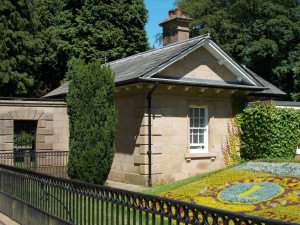
The land at present day Worden Park was acquired by Henry Farington in 1534 and would stay with his family for over 400 years. The earliest hall on the site was called Shaw Hall and this is shown on a 1725 map of the estate. The hall was enlarged in 1742 by Sir William Farington and a later account described it as a “large irregular stuccoed pile, containing a suite of apartments used as a museum stored with natural curiosities, busts, marbles…paintings… some of them frescoes found in the ruins of Herculaneum…” These artefacts were brought back by Sir William on the then fashionable Grand Tour of Europe.
In 1837 James Nowell Farington aged only 24, inherited Shaw Hall. He soon decided that both house and estate needed to be enhanced. Much of the house had dry rot, so a large part was demolished and a major rebuild to the designs of the architect Anthony Salvin took place over five years. It was now that the name change occurred and the grand house from then on was known as Worden Hall. Some of the older parts that survived the rebuild included the Derby Wing (or Service Wing) built by George Farington in the early 18th century and the nearby farm buildings. The gardens and parkland had new creations added, many of which we can still see today: the sunken lawn, the Hornbeam tree maze and the picturesque follies of the ice house and stone arch over the Shaw Brook.
In 1847 James married Sarah Esther Touchet, a wealthy heiress. A huge wedding was held at the new Worden Hall. This lavish celebration featured a ball for 600 guests and even a hot air balloon. There was a Children’s Treat for 1500 pupils and a special meal for over 200 of the local poor. Sadly James died just 8 months later and the running of the estate was taken over by Sarah and his two sisters, Mary Hannah and Susan Maria. His sisters were remarkable women in their own right by the restrictive standards of the times: Mary Hannah was a keen biologist and Susan Maria specialized in history as well as being active in local charities and the Local Board (what would now be the local council). During the 1860s Cotton Famine the sisters organized relief for unemployed factory workers.
In 1910 Henry Novel Farington inherited Worden, and he was to be the last squire of the property. Soon after World War I parts of the estate began to be sold off, presumably to raise money. A devastating fire struck the housel in 1941, severely damaging much of the newer parts of the hall and leaving it a burnt out shell. Henry died six years later and a huge part of the building’s historical contents, collected over so many years by the Faringtons, were auctioned off. In 1951 the estate was bought by Leyland Urban District Council who opened the 60 hectare grounds as a park for the public that same year.

There is much of historical interest that still remains for visitors to see today. The neoclassical North Lodge and gateway with its Tuscan style columns are still one of the main entrances to the parkland. The road that leads from it into the grounds is probably one of the original estate drives shown on the 1725 map. It forms a crossroads with another original drive ‘The Avenue’ which leads down towards the hall.
The burnt out part of the new hall was demolished in the 1950s, but the older Derby Wing (or Service Wing) dating from the 1700s house is still in good condition. Although much modified it’s an impressive building- built of brick and standing on a stone plinth. This section used to contain the servants hall and kitchen. Inside a triple arched fireplace dates the structure with a keystone of 1736. It stands besides the Grade II listed farm buildings which include a barn, stable block and a huge brewhouse. These are now used for a variety of businesses including artisans and artists, craft and gift shops and a popular café.

The conservatory that once joined onto the new hall has seen better days and is looking very neglected. Originally built in 1860 its wooden frame is now beyond repair and will be replaced by an aluminium one in the same style in 2018. Hopefully it will be restocked and be a welcome addition to the formal garden it faces onto. The garden was originally designed by William Andrews Nesfield a noted landscaper of his time, who often worked with his brother-in-law Anthony Salvin, the above mentioned architect of Worden Hall. Nesfield is best known for his work at Kew Gardens and Castle Howard, but here he has left us a fiendish hedge maze. It is very tricky to solve right from the start- it has two entrances, one of which is false !
The Georgian walled kitchen garden has been recently restored and restocked, with plants available for sale. It has a fascinating history of its own and to see our site post click here. The extensive park grounds feature a woodland walk and the picturesque Grade II ice house and arch follies (see here). A model ride on steam railway is a big draw on the weekends.
Site visited by A. and S. Bowden 2017
Access and Opening Times
Worden Park is open 9am- 5pm daily. The car park is free.
All of the above mentioned amenities (maze, gardens, parkland) are also free. A new large pond has been created and there is an excellent playground for children. The model steam railway does not charge, but visitors can make a donation in a box if the wish.
Nearby, just a short walk away Leyland Town Cross and Well and Leyland’s Tudor Grammar House: South Ribble Museum
References
The History of Leyland and District, David Hunt (1990), Carnegie Press
https://www.leylandhistoricalsociety.co.uk/ow-2—back-lane—hall-lane.html
https://www.leylandhistoricalsociety.co.uk/listed-leyland-03.html
http://www.pastscape.org.uk (entry on Worden Hall)
https://historicengland.org.uk/listing/the-list/list-entry/1000955
https://www.southribble.gov.uk/wordenpark
http://www.visitleyland.co.uk/worden-park


Comments are closed.